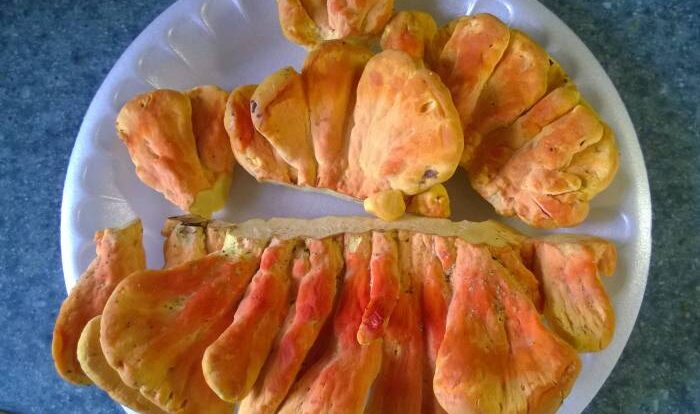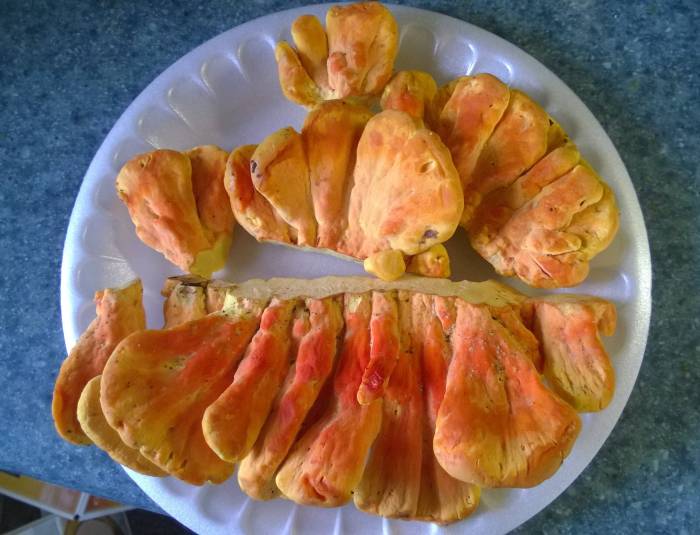
Embark on a culinary adventure with our chicken of the woods recipe, a delectable guide that unlocks the secrets of this vibrant forest fungus. From identifying and harvesting to cooking and preserving, this recipe will transform you into a master of the woods.
Delve into the unique characteristics and nutritional benefits of chicken of the woods, and discover its versatility in various culinary creations. Learn the art of selecting the perfect specimens and explore sustainable harvesting practices to ensure the preservation of this forest treasure.
Introduction to Chicken of the Woods
Chicken of the Woods, also known as Sulphur Shelf or Chicken Mushroom, is a unique and sought-after edible mushroom found in various forests worldwide. It is renowned for its distinct appearance and delectable flavor, resembling chicken meat when cooked.
This fungus belongs to the genus Laetiporusand typically grows on the trunks of dead or dying hardwood trees, especially oaks. Chicken of the Woods forms large, shelf-like structures that can range in size from a few inches to several feet across.
Appearance
The appearance of Chicken of the Woods is striking and unmistakable. It features bright orange to yellow caps that are often covered in small, velvety pores. The caps are typically flat or slightly undulating, with a smooth margin. The flesh is white and firm, becoming tender when cooked.
Nutritional Value and Health Benefits
Chicken of the Woods is not only a culinary delicacy but also a nutritional powerhouse. It is a good source of dietary fiber, protein, and vitamins, including vitamin C and vitamin D. It also contains antioxidants and other bioactive compounds that may offer health benefits, such as reducing inflammation and supporting immune function.
Culinary Uses of Chicken of the Woods

Chicken of the Woods is a versatile mushroom with a unique flavor and texture that make it a popular choice for culinary applications. Its meaty texture and mild flavor make it a suitable substitute for chicken in various dishes, hence its common name.
The versatility of Chicken of the Woods extends beyond its ability to mimic chicken; it can be cooked using various methods, including sautéing, grilling, roasting, and more. Each cooking method brings out different flavors and textures, allowing for a wide range of culinary creations.
Selecting the Best Chicken of the Woods
To ensure the best flavor and texture, it’s crucial to select fresh and young Chicken of the Woods mushrooms. Look for specimens with a firm, springy texture and avoid those that are slimy or mushy. Younger mushrooms tend to have a milder flavor and a more tender texture.
Cooking Methods
- Sautéing:Sautéing Chicken of the Woods in butter or oil is a quick and easy way to cook it. The mushrooms will develop a slightly crispy exterior while remaining tender on the inside.
- Grilling:Grilling Chicken of the Woods over medium heat imparts a smoky flavor and a slightly charred exterior. This method is perfect for adding depth to the mushroom’s flavor.
- Roasting:Roasting Chicken of the Woods in the oven allows for even cooking and caramelization. The mushrooms will develop a rich, nutty flavor and a slightly crispy texture.
Recipes
Here are a few recipes that showcase the versatility of Chicken of the Woods in different cooking methods:
- Sautéed Chicken of the Woods with Garlic and Herbs:Sauté Chicken of the Woods in butter with garlic, herbs, and a splash of white wine for a flavorful and aromatic dish.
- Grilled Chicken of the Woods with Lemon and Thyme:Grill Chicken of the Woods over medium heat and brush with a marinade made of lemon juice, thyme, and olive oil.
- Roasted Chicken of the Woods with Parmesan and Breadcrumbs:Roast Chicken of the Woods in the oven and top with a mixture of Parmesan cheese and breadcrumbs for a crispy and savory dish.
Identifying and Harvesting Chicken of the Woods: Chicken Of The Woods Recipe

Identifying Chicken of the Woods (COTW) is crucial to avoid confusion with lookalike species. Key features include:
- Bright orange to yellow shelf-like caps
- Pores on the underside instead of gills
- Chicken-like texture and flavor
Sustainable Harvesting Practices
COTW plays an essential role in the ecosystem. Sustainable harvesting ensures its preservation. Follow these guidelines:
- Harvest only mature mushrooms with fully developed caps.
- Use a sharp knife to cut at the base, leaving the base intact.
- Harvest no more than 1/3 of the mushrooms in an area.
- Avoid damaging the surrounding environment or disturbing other organisms.
Preserving the Habitat
COTW thrives in specific habitats, often near oak trees. Protecting these areas is vital for its survival. Consider the following:
- Avoid trampling or disturbing the ground where COTW grows.
- Leave dead logs and fallen branches undisturbed.
- Respect the natural balance of the ecosystem and avoid introducing non-native species.
Creative Culinary Experiments with Chicken of the Woods
The culinary potential of Chicken of the Woods extends far beyond the traditional sautéed or roasted preparations. With its meaty texture and mild flavor, it serves as a versatile ingredient that can elevate a wide range of dishes. Encourage experimentation with Chicken of the Woods by exploring innovative recipes and flavor combinations.
Consider incorporating it into salads for a crunchy and savory element, soups and stews for a hearty and flavorful addition, or pasta dishes for a unique and satisfying twist.
The following recipes showcase the versatility and culinary potential of Chicken of the Woods:
Salads
- Chicken of the Woods and Arugula Salad with Balsamic Vinaigrette: Combine sautéed Chicken of the Woods with fresh arugula, shaved Parmesan cheese, and a tangy balsamic vinaigrette for a light and refreshing salad.
- Chicken of the Woods and Roasted Beet Salad: Roast Chicken of the Woods with earthy beets, goat cheese, and a honey-mustard dressing for a flavorful and colorful salad.
Soups and Stews
- Chicken of the Woods and Wild Rice Soup: Add sautéed Chicken of the Woods to a creamy wild rice soup with vegetables and herbs for a hearty and comforting meal.
- Chicken of the Woods and Bean Stew: Combine Chicken of the Woods with beans, vegetables, and a flavorful broth for a rustic and satisfying stew.
Pasta Dishes
- Chicken of the Woods and Alfredo Pasta: Sauté Chicken of the Woods and add it to a creamy Alfredo sauce tossed with pasta for a rich and indulgent dish.
- Chicken of the Woods and Pesto Pasta: Combine sautéed Chicken of the Woods with a vibrant pesto sauce made with basil, pine nuts, and Parmesan cheese for a flavorful and aromatic pasta dish.
Storage and Preservation Techniques for Chicken of the Woods

Proper storage and preservation techniques are crucial to maintain the freshness, quality, and nutritional value of Chicken of the Woods. Understanding the appropriate methods can extend its shelf life and allow you to enjoy its unique flavor and texture for an extended period.
Fresh Chicken of the Woods should be stored in a cool, humid environment to prevent dehydration. Wrapping it loosely in a damp paper towel and placing it in a refrigerator can help maintain its moisture content for up to a week.
Alternatively, you can store it in an airtight container with a slightly damp paper towel to absorb excess moisture.
Drying
Drying is an effective method for long-term preservation of Chicken of the Woods. Slice the mushrooms into thin strips and spread them evenly on a drying rack or baking sheet lined with parchment paper. Place them in a warm, well-ventilated area with low humidity.
The drying process can take several days to a week, depending on the temperature and humidity levels.
Freezing, Chicken of the woods recipe
Freezing is another option for long-term storage. Clean and slice the mushrooms, then spread them on a baking sheet and freeze them for several hours. Once frozen, transfer them to airtight freezer bags or containers. Frozen Chicken of the Woods can be stored for up to a year, but the flavor and texture may change slightly over time.
Pickling
Pickling is a traditional method of preserving Chicken of the Woods. Slice the mushrooms and pack them tightly into a jar. Create a brine solution by dissolving salt and vinegar in water, then pour it over the mushrooms, ensuring they are fully submerged.
Seal the jar and store it in a cool, dark place for several weeks before consuming.
Final Review
As you experiment with our chicken of the woods recipe, let your creativity soar. Incorporate this culinary gem into salads, soups, stews, and pasta dishes, unlocking a world of flavors. Embrace the versatility of chicken of the woods and elevate your cooking to new heights.
With proper storage and preservation techniques, you can savor the taste of the forest all year round. Learn the secrets of drying, freezing, and pickling to extend the shelf life of chicken of the woods and enjoy its unique flavors whenever the craving strikes.
Questions Often Asked
What are the key identifying features of chicken of the woods?
Chicken of the woods is characterized by its bright orange to yellow coloration, resembling the plumage of a chicken. It has a shelf-like or fan-shaped structure with a velvety texture and a slightly bitter taste.
How can I ensure sustainable harvesting of chicken of the woods?
Always harvest only what you need, leaving plenty for others to enjoy. Cut the mushroom cleanly at the base without damaging the root system, and avoid disturbing the surrounding ecosystem.
Can chicken of the woods be stored for future use?
Yes, chicken of the woods can be dried, frozen, or pickled to extend its shelf life. Drying is a great option for long-term storage, while freezing preserves the texture and flavor for several months.





